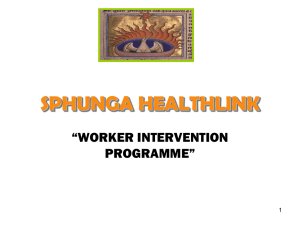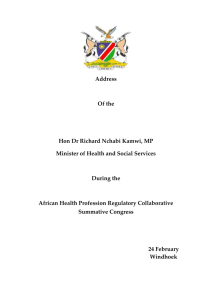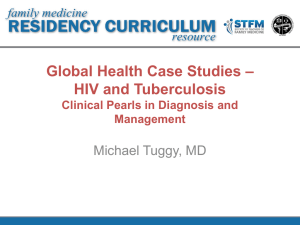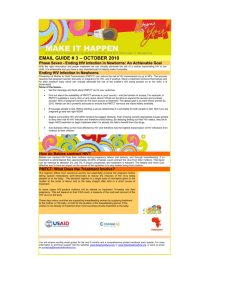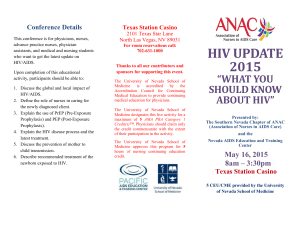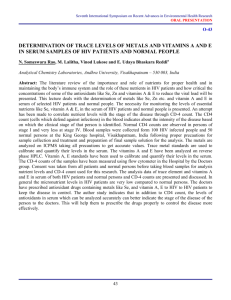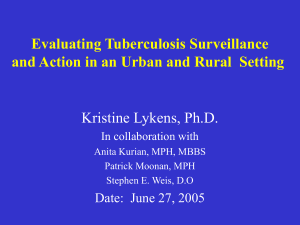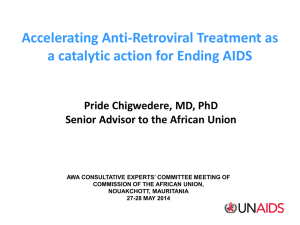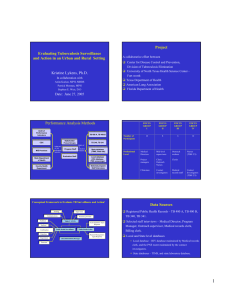WEAB030 – A Training Needs Analysis Of Health Workforce
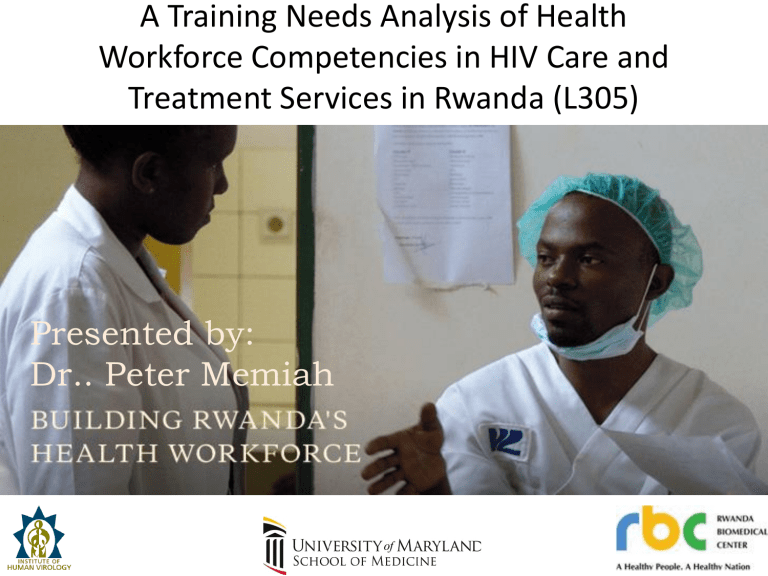
A Training Needs Analysis of Health
Workforce Competencies in HIV Care and
Treatment Services in Rwanda (L305)
Presented by:
Dr. Peter Memiah
Objectives
• Identify the existing and emerging capacity gaps among medical health care providers currently in practice in health care
• Assess the current clinical practice in managing HIV/AIDS patients at health facility level
• Identify the type of trainings, offered and mechanism for ongoing professional development for HIV
Study Design
• Cross-sectional survey
• 30 randomly selected health facilities
• 5 provinces
• 20 health centers
• 10 hospitals
• High volume and low volume sites
• Methods:
Training needs Assessment self-reported (gap analysis)
Medical Chart review
• Sampling Proportionate to size
2 Referral hospitals
8 district hospitals
19 Health Centers
1 NGO
Self Administered Questionnaire
• People interviewed
Medical officer in charge of clinical supervision/mentorship (DH)
Head of ART clinic, nurse prescriber
Head of VCT/PMTCT service ( HC)
Laboratory technologist/technicians
In charge of pharmacy
People involved directly in provision of HIV Services
Study Criteria
Self Administered Questionnaire
• Staff from DH and HC which provide the full range of adult and pediatric HIV
Care, treatment and prevention including VCT and PMTCT
• Able to provide consent
Medical Record Review
• Medical Charts for Patients who have been on ART
>6months inclusive of terminated/dropped out patients
Findings: Self- Administered
Questionnaire
Health Care Providers Gender
Distribution
• 107 responses
• 73% response rate
Percentage
Males
35%
Females
65%
• 107 responses
• 73% response rate
Professions
Social
Workers
6%
Counselors
15%
Pharmacy
Personel
6%
Medical
Doctors
3%
Lab
Personel
16%
Nurses
54%
11-15
Years
5%
Years of Experience
<1 year
8%
6-10 years
38%
1-5 years
49%
Number of different health professionals versus the time when they provided care last for
PLHIV
Training in the past year
HIV/AIDS Knowledge
MO scored higher while counselors and lab had low scores all across
Summary of findings
• Guidelines were available in about ¾ of the facilities and utilization was at 79%
• Nurses care for 4 times as many patients as compared to physicians
• 8% of Nurses provide care without any HIV training
• 32% of nurses claimed not to know the significance of CD4 counts- drug resistance- VL
• Most nurses had responsibilities of training other staff- 40 %
Findings: Peds Chart Abstraction
Pediatric Patients
112 Peds
Care ended
10%
Female
51%
Active
90%
Gender
Male
49%
Summary of findings
• 81% VL of < 1000copies/ml
– Gender disparity (pvalue= 0.037)
• Males were initiated on trx earlier than Females
(99 vs 135)
• Diagnosis: Rapid test (83%) and was the most used method for HIV test
• Majority (94%) of children were above 5 years
• Neonatal prophylaxis and maternal prophylaxis/treatment was mostly missing in patient chart
• 80% had exclusive breastfeeding
• Diarrhea (wasting) was the leading Opportunistic
Infection
Findings: Adults Chart Abstraction
Demographics
832 patients
Male
37%
Female
63%
The median age for adult patients was 41.5 years
Summary of findings
• 89% VL of < 1000copies/ml
– Gender disparity (pvalue= 0.001)
• 11% had trx failure and only 2% were put on 2 nd line- up to 6 months of repeat testing for failing patients
• Age baseline CD4 and (D4T)current regimen were significantly associated with VL failure
• Females were initiated on trx earlier than Males
(265 vs 339)
• There was a significant CD4 increase (av 137) between baseline and recent CD4 (pvalue=0.001)
Cross-Cutting Issues
• Poor documentation- role of CQI teams?
Lesson Learnt / Way forward
• Mentorship and supervision- gaps
• Task Shifting (and multi-tasking)
• Utilization of National guidelines
• Competency based Pre/In-Service Training
– Cadre specific
• Documentation is crucial
– Enriching the Tracplus system
• More in-depth analysis
• …Upcoming publication JAIPAC….
Co-Authors: Prof. Baribwira Cyprien; Dr. Kiromera Alphonse; Dr. Sebeza
Jackson, Dr Riedel David;
..IDI- Uganda ….CDC….RBC….HCP at all the facilities
